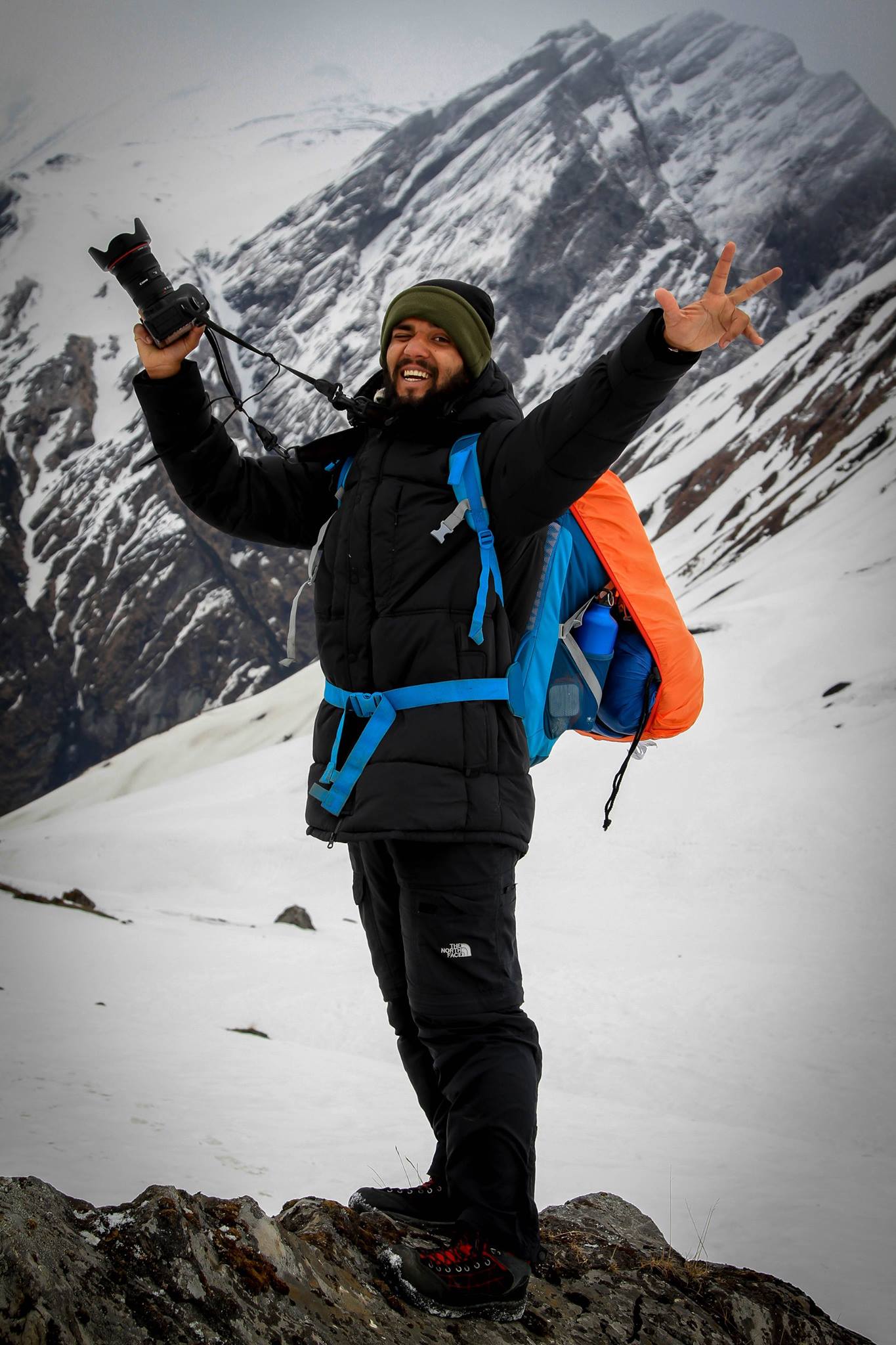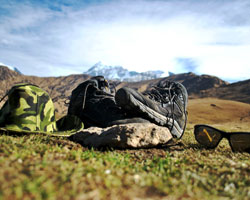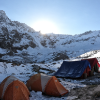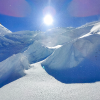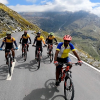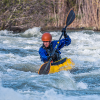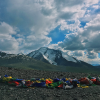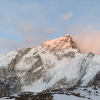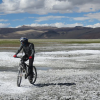Reading the answer to this seemingly complex question will only take about 10 minutes of your time. However, the entire process from planning to preparing to summiting to a safe return from the highest mountain in the world would take anywhere between 1 to 2 years. Acquiring the passion, grit, and experience needed to scale Everest can sometimes take decades.
We’ll be tackling the question in three parts:
- The Process: How people get to the top
- Money, Fitness & Experience: The three greatest barriers
- Road map as suggested by Bikat Adventures

Picture Courtesy: Vivek Thakur
The Mountain: A Brief History
The top of Mount Everest (known as ‘Sagarmatha’ in Nepali & ‘Chomolungma’ in Tibetan) is Earth's highest point above sea level with the current official elevation at 8,848 M (29,029 ft). Located in the Himalayas, the international border between Nepal and China runs across its summit point. In 1865, Everest was given its official English title by the British Surveyor General of India, who picked the name of his own predecessor, Sir George Everest.
Experienced mountaineers will tell you that the expedition does not pose substantial technical hurdles for the route is very well laid out and broken into. However, this is not to say that the exercise does not present challenges related to altitude, weather, wind, avalanches and the biggest of them all, the infamous Khumbu Icefall – moving blocks of ice which are considered to be the most dangerous stage of climbing Mount Everest from its South face.
Based on records available, the first attempt to reach the summit was made by British mountaineers from the North ridge on the Tibetan side. The 1924 story of George Mallory and Andrew Irving which still remains one of the biggest mysteries waiting to be solved after all these years, leaves the question of whether or not Everest was first climbed successfully as early as 1924, unanswered. But the first recorded ascent of Mount Everest was finally made in 1953 by Tenzing Norgay and Edmund Hillary via the southeast ridge. The first successful summit using the north ridge was accomplished by a Chinese team, seven years later, in 1960.

Picture Courtesy: Mario Simoes
1. The Process: How do people get to the top?
Let’s break this further down into the following:
Location: Where must one climb from?
Even though Mt. Everest can be summited from both Nepal & China, most agencies operate in Nepal, as climbing in Tibet is much more expensive and has more stringent rules. An experienced mountaineer will tell you that the two routes are equally difficult but the nature of the challenges faced are very different on each. The southeast ridge approach from Nepal exposes climbers to the hazardous Khumbu Icefall, but past that, this route makes more sense since the summit day is shorter. The northern ridge on the Tibetan side has its own set of advantages and disadvantages. You can drive your jeep straight to the base camp but in this case, mountaineers have to face a route that runs for several kilometers over 27,000 feet before they reach the summit.
Timing: What are the best weather windows?
Most outfits plan to summit Mt. Everest in May. This month presents a small window of time when the temperatures are warmers and the high-altitude winds are less harsh. Acclimatisation rounds begin as early as April.
Duration: How much time do you need?
The entire trip from start to finish ends up being close to 60 days long. The group takes about 2 weeks to reach the Everest Base Camp which is located above 17000 ft. Another 2 weeks are spent on acclimatization walks at the base camp and waiting for the right weather conditions. Once the conditions are more favorable, the team climbs for another 5 days to reach the summit camp and attempt a summit push.
Route: What places do you encounter on the way?
Climbers who choose to take the southeast ridge (from Nepal side) report for the expedition in Kathmandu. From there, they take a short flight to a hilly airport in Lukla village. The trek from Lukla to Everest Base Camp takes about 10 days. Post the acclimatization rounds, summiting Mt. Everest is a rigorous 5-day round-trip from base camp to base camp. After the precarious Khumbu Icefall, the expedition slowly moves up towards higher camps going from camp 2 to camp 3 and camp 4 before setting up summit camp near South Col.
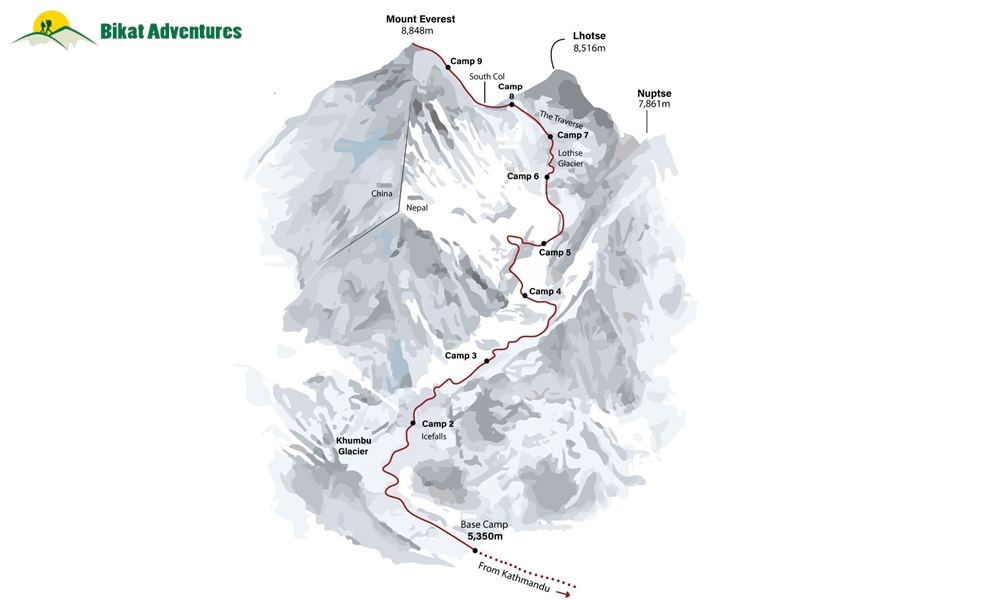
Regulations: What are some of the safety regulations set up by the government?
With the intention of reducing mishaps, the Nepal government recently announced some new regulations that were put in place in 2020.
- Climbers must be accompanied by a guide at all times – no solo climbs.
- Climbers must have summited a 7,000m peak prior to attempting Everest.
- People over the age of 75 are banned from climbing.
- People who are blind are banned from climbing.
- Double amputees are banned from climbing.
- Climbers will have to provide a medical report
- Climbers will have to get appropriate adventure insurance
Conditions: What is it like on the mountain?
At 8,848M., the air pressure at the summit is only a third of what we’re accustomed to at sea level. Consequently, climbers struggle to breathe in enough oxygen required to support the functioning of an adult human body. A lower oxygen intake along with other extreme conditions expose climbers to the risk of conditions such as AMS, HAPE & HACE. Additionally, the risk of frostbites becomes quite real at such altitudes and temperatures. When tasked with the responsibility of pumping blood (providing oxygen & warmth) vital organs are the first priority, fingers/toes are last. Dangers present during the expedition include subfreezing temperatures and extremely high altitude, especially when the supplemental oxygen runs out or when you get caught in a sudden storm. Deaths from falls or avalanches, and other health problems like heart attacks are not uncommon under such conditions. Over-exposure in the 'death zone' (any elevation above 8000M) is another major cause of concern especially due to overcrowding on the mountain causing traffic jams on the single route used by climbers to go up and down the mountain.
Numbers: How many climbers climb Everest each year?
Because of the popularity of the mountain and the increasing number of outfitters offering climbs to reach the top of the world, the peak attracts heavy traffic of climbers each year. Some traditional mountaineers who believe in self-supported climbs call the Everest expedition a tourism activity because of the number of people who attempt the peak each year. According to estimates based on data from the last few years, more than 600 people reach the summit of Everest each year, which is about half of the number who actually attempt it.

Picture Courtesy: Vivek Thakur
2. Money, Fitness & Experience: The three greatest barriers
Barrier 1: Money
It is not uncommon to hear climbers tell you that the only thing harder than the climb itself is raising the funds for it. The cost of climbing Everest begin at the stage of training which is a good 12 to 15 month long period. Without optimum levels of mental and physical preparedness, there is no way you can even attempt to undertake this massive endeavor. Even if you are built for it, it is not necessary that you can afford it.
Since there are so many variables involved, we use this section to detail out the different heads of of expenditure rather than breaking it down into actual costs.
- Mountain Craft & Mountaineering: This stage includes the entire cost incurred right from the moment you picked up mountaineering as a hobby to the moment where you finally are technically adept at the craft. It’s nearly impossible to put a price tag to this exercise since the pace and time required varies from person to person. However, there is a great option of learning all there is to learn about mountaineering in under INR 50,000 by getting a Basic & Advance Mountaineering Course certification in India. Fortunately, we have a fairly good infrastructure in our country, in the form of 5 pioneering institutes, to learn mountaineering.
- Fitness Training: We will deep dive into this aspect in the next section. But overall, the costs of hiring a trainer and sticking to a dedicated training schedule will cost an estimated amount of USD 8,000. According to one Indian climber, the total amount spent of training itself was upwards of INR 5 lakhs.
- Endurance Expeditions: Once you’re confident in your mountain craft and you’ve managed to get considerably fit, the next logical step is to start your climbing journey with some semi-technical height gains (like peaks above 6000M) to eventually move to expeditions above 7000M, eventually getting to the 8000M mark. Again, putting a definite number down as cost incurred during this stage is fairly difficult as it would solely depend of the peaks you choose. Expeditions in India can cost anywhere between INR 80,000 to INR 2.5 lakhs.
- Personal Gear & Equipment: Although you can rent most of the items required for your expedition, it is best to have personal gear to develop a sense of comfort with your equipment and clothing since you are going to be spending a lot of time with them and developing a relationship with each item is especially important. You also shouldn’t compromise on quality since buying a cheaper pair of gloves might cost you a hand to frostbite. Speaking of which, an expedition grade pair of mittens alone can cost you upwards of USD 200! Additionally, a pair of high-altitude boots will set you back for another USD 1000, so will a good down-suit.
- Agency costs: The agency/operator/outfitter that you choose to go with majorly dictates the cost of your expenditure, with a wide range of USD 25,000 to USD 75,000 to even USD 100,000 per person, depending on factors such as desired comforts, the amount of bottled oxygen, Sherpas, etc. The typical cost with a western agency is close to USD 45000. In comparison, local operators range between USD 20,000 to USD 40,000. The cost covers Nepalese permit cost (USD 11,000), guide charges, bottled oxygen, high altitude equipment (tent, sleeping bag, etc), medical care, food.
- Extras: Other costs to consider are travelling cost, adventure insurance, and tips.
To arrange for funds, you can look through the following options and decide which format works best for you.
- Sponsorships - For athletes with considerable standing in their respective fields. Based on what value you’re offering in return to the sponsors, you can seek sponsors who can cover part of or the entire expedition expenditure. You can look for a single sponsor or multiple sponsors who can fund different parts/stages of your expedition.
- Donations - Additionally, you can share your story and ambitions on various crowdsourcing platforms and seek donations to fulfill your dreams.
- Mountaineering Clubs - If you are a member of any of the many private mountaineering clubs present in India, you can join their periodic expeditions or seek aid from the club.
- Self-Sponsor - If none of these work, self-sponsoring your climb is always an option!

Barrier 2: Fitness
The second major obstacle for achieving this feat is adequate fitness – from being in the right shape to building sufficient endurance. For a task this gigantic, the extent of fitness & endurance obviously needs to be extremely high. If you hate taking the stairs when the elevator breaks down, you probably have a very long way ahead of you! For those with an active lifestyle, dedicated fitness training for Everest should begin about 8-12 months before the attempt. ‘Being in the best shape of YOUR life’ may not cut it, so let’s get you in ‘Everest Shape’.
If you ask x number of people for the best way to train for Everest, you’ll probably get x number of different responses, and quite frankly, there’s no ‘perfect approach’. Some climbers have had success due to CrossFit, others benefitted from cycling or swimming. To each his own.
We recommend a mixture of gym & outdoor training such as long and hard days of mountain trekking with a heavy rucksack. The goal should be to push yourself and build physical & mental endurance without harming your body. To get your heart, lungs, abs, thighs & calves (don’t forget training your mind!) in the best shape possible, let’s create a 3 point checklist.
- Foundation: Before you begin your preparation, having a strong foundation is important to withstand the rigorous training and also to avoid injury. Having a pre-existing active lifestyle is a prerequisite along with the right body weight & BMI. If you don’t think you’re there yet, take 3 months to get to that point.
- Stamina: Defined as the duration that your body can perform in peak condition, this phase of training takes about 6 months. Working on the important muscle groups along with increasing aerobic capacity should be the focus of this phase.
- Endurance: In comparison, endurance is defined as the duration that your body can perform at less than peak capacity. Long days of mountain trekking should increase endurance while also strengthening your mental discipline. Utilize rest intervals by mixing it up - play a sport, go for a swim, cycle around the countryside - the important thing being keeping yourself motivated.
Read: How to best prepare for a mountain climbing expedition: All you need to know
If you followed all the above, maintained a balanced diet, took adequate rest in between, then you should be feeling pretty good a few months before leaving for Nepal. The following are a few things to remember when on the mountain.
Help your body: All mountain enthusiasts have heard this golden rule of thumb - “climb high, sleep low”; make sure you stick to it. Another suggestion to help your body acclimatize better is to keep your approach up the mountain as slow as necessary. One thing that you need to keep in mind is that the above-mentioned training module has to happen before you leave home. Some fairly fit people try to make up for the lack of preparation by training a bit at the Everest base camp. Once at 17500 ft., the altitude prevents muscle building and all the physical activity actually deteriorates your body.
Help your mind: Just like all the other requirements discussed in this blog, mental toughness is a non-negotiable requirement to having a successful Everest experience. Mental toughness is not just limited to the ability to push yourself physically but also the ability to keep your emotions in check and stay level-headed regardless of the situation. It happens more often than not that people are unable to stay focused & motivated for the entirety of the 2 months that this expedition demands. In this duration, about every Everest aspirant falls sick, the ailment could be internal or external, minor or major. In such a condition, almost all ailments can be tackled with but if you give in mentally, you’re probably done physically too.
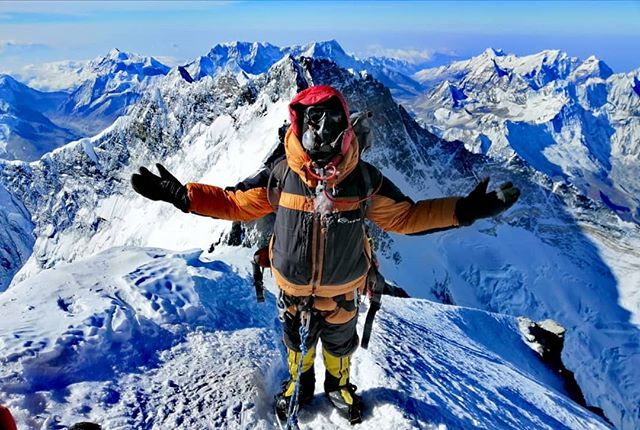
Picture Courtesy: Sagar Kasana (successfully summited Mt. Everest on 22nd May 2019)
Barrier 3: Skills/Experience
Even though Mt. Everest is nowhere close to being one of the most technical climbs, you still need to have certain skills and a level of understanding about the equipment you’ll be using as well as the pros and cons of certain situations. It goes without saying that technical competence is required for a safe trip up and down such a high mountain peak. Regardless, some people go there extremely ill-prepared and in the event that a small fraction is able to successfully summit, they end up setting a bad example for others. The others may not share the same amount of extreme luck and therefore, best case scenario, may not succeed in summiting. Don’t rely so heavily on luck or your Sherpa and take ownership of your expedition and summit-success by mastering some of the following technical skills. Remember, it is also your duty as a responsible climber to be as self-reliant as possible so you are not putting others on the mountain at an increased risk.
1. Basic Rock Climbing (indoors or outdoors)
Skills: Use of harness, helmet, carabiners, belay device. Climbing principles, belaying the lead climber, tying knots like figure of 8, clove hitch.
Timeline: 2-4 months (minimum) depending on how quickly skills are acquired. Many months or even years of experience will be very helpful.
2. Rappelling
Skills: Descending on slabby rocks, vertical rock faces, different types of landing areas, how to tackle an overhang, rappelling diagonally. Progress to rappelling without a safety rope.
Timeline: A few sessions to many weeks or months. This is an essential skill but can be picked up quite easily. It is also a skill that is easy to get wrong, particularly when tired and not concentrating so you need to practice it till it becomes muscle memory.
3. Use of crampons & ice axe on snowy terrain
Skills: Kick steps diagonally up or down a slope, cutting steps using ice axe, self-arrest with or without snow axe, how to walk with crampons on.
Timeline: The more time spent doing this the better as beyond the base camp you are basically existing fully in snow. Walking on snow should come as easy to you as walking on land.
Skills: Previous experience with navigating all the geographical features of high altitude like glaciers, hidden and open crevasses, icefalls, rock fall areas, seracs, overhang and the like.
Timeline: Practice as much as possible so that every skill and muscle movement becomes second nature.
5. Campcraft
Skills: Packing your rucksack with the right things and in the right way, a good understanding of the layering system of clothing, being acquainted with your own body (when to take breaks and take fluids/food), how to pitch a tent, how to use a camping stove along with some basic cooking skills, the tent routine.
Timeline: Practice as much as possible so that every skill and muscle movement becomes second nature.
6. High-altitude experience
It is an absolute necessity that you’ve been to high altitudes before. Even though we define high altitude as anything above 3000M, in this particular case, we’re talking about having multiple experiences above 6000M to your credit. Having had a 6000M experience will not spare you from the process of acclimatization again when you go for Everest for your body needs to acclimatize back to the original state once you’re back home. However, it’ll prepare you mentally and also give you an insight into how your body responds to high altitudes. It’s extremely helpful when the feeling of breathlessness on exertion does not feel alien.
Although not a mandatory requirement, it is suggested the climber has basic knowledge of HAPE & HACE.
The aforementioned points are just some of the skills that a climber needs to have. To get a full scope of mountaineering and become a government certified mountaineer, it is highly recommended that all Indian aspirants go ahead and enroll themselves for the Basic Mountaineering Course (you need to ace the grade) and subsequently progress to the Advance Mountaineering Course (AMC). The courses are offered by government institutions at highly subsidized fees and are designed in a way so as to prepare you for all types of mountaineering obstacles. The most renowned institutes in India are NIM Uttrakhand, HMI West Bengal, ABVIMAS Himachal Pradesh, JIM&WS Jammu Kashmir, and NIMAS Arunachal Pradesh.
Even though you can get a permit for Mount Everest without having any certification, having an AMC certification is necessary for Indians to undertake an expedition to any technical peaks above 6000M in India, as mandated by the Indian Mountaineering Foundation (IMF). Since it’s a good idea to prepare for Everest by climbing multiple technical peaks within India and gradually moving up to 7000M peaks, it in a way becomes an indirect requirement for Indians to complete their AMC before they can head out to touch the highest point on earth.

Picture Courtesy: Mario Simoes
Bikat Road Map
Following the road map as shown in the illustration below will prepare you to take care of almost any obstacle that is likely to come your way. The treks mentioned are just to provide a reference as to the level of difficulty that needs to be tackled in order to be ready for the ultimate challenge. You can also get in touch with our team and choose from a plethora of options available within each difficulty level and accordingly move your way up the Bikat Rating Scale.

If you dream of seeing yourself on the top of Everest, you have a long way ahead of you. There’s no better time to start than now. We are here to offer support in any way that we can. All the Best! ☺
